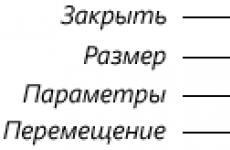The plasma TV ripples. Why does the TV screen ripple and what should I do? Basic TV problems
Sometimes it happens that a user buys new TV in order to enjoy watching while sitting on a comfortable sofa in your apartment and lazily changing channels, but by chance, interference and ripples appear on the screen.
They not only prevent you from watching TV normally, but also harm your eye health. Flickering, noise and other interference greatly tire the eyesight, and if a person tries to look at something, he leans forward and strains his spine. Accordingly, you should not expect pleasure from watching your favorite programs.
If you are bothered by interference on the TV screen, then you can contact the repair site or try to deal with the problems yourself. And how to do this, you will learn from the article.
What kind of interference is there on the screen?
The first step to solving a problem is diagnosing it. You should know that there are different types of interference on the TV screen, here are their main types:
- A ripple that begins with a hiss.
- Stripes.
- "Trembling" of the image.
- A humming sound that occurs suddenly or is constantly present.
- Net.
- Interference that is difficult to describe.
You should know that such problems are inherent to all TVs, regardless of the model, brand or year of manufacture. Both old tube TVs and modern plasma TVs break down equally. The causes of interference vary widely, from faulty power cords to serious damage inside the device.
If you have determined what kind of interference is present on your TV screen, then it’s time to continue the diagnosis.
Causes of Interference
It is worth gradually understanding the two main causes of interference:
- Faulty wiring.
- Problems with the antenna.
In the first case, you should inspect the wires for any faults, for example, damaged wires or poor insulation. If the wires are not grounded or not well shielded, then according to the known laws of physics, the electromagnetic field is not contained within the wires and the image quality is degraded by the presence of ripples and noise. If you are convinced that the problem is in the wires, then the solution is very simple; you need to replace the cables with new ones that have better properties.
After carefully inspecting the wires, did you find a problem? In this case, there is a possibility that interference on the TV screen was caused by the antenna. In order to verify this, you need to diagnose the antenna cable. First you need to inspect the plug, evaluate the quality of the contact, changes in states during operation, try to turn it off and on. If there are no problems with the cable, then a filter with a ferrite shell will help solve the problem; it will reduce interference.

Small ripples - the problem is inside
If you have a brand new LCD TV and you are very upset by the appearance of ripples on it, then there may be several reasons for this: a faulty capacitor, a broken video card, or outdated driver video cards.
You can replace the driver yourself, but you must understand that if the problem persists, your money will be wasted. You can contact the workshop website and experienced technicians will diagnose the problem and then solve it. Independent actions in this matter are harmful and can only worsen the situation.
Other causes of interference
If stripes appear on the screen, this may be due to various home appliances or other sources of interference that prevent the signal from the antenna from reaching the TV without hindrance. In this case, installing a directional antenna will help. Also, such interference can occur only on some channels, this will help manual update TV settings.
For owners digital television The problem can be solved very simply. To do this, you just need to call the service provider, describe the problem and the provider will give instructions that will help in solving the problem. If it turns out that he did not help you, then the only thing left is the help of professionals.
The TV often flickers, especially noticeable when the brightness changes. In order to avoid this trouble, you need to adjust the image using special functions provided by the options - brightness and contrast. A similar problem can arise when using devices from the popular company Samsung.
Of course, if you cannot or do not want to deal with the breakdown of your TV, then you can always contact the workshop site. Our technicians will quickly and inexpensively fix all problems and you can enjoy watching TV again. Noise and interference spoil the effect of films, and if problems cannot be avoided, then they need to be eliminated; this is the only way to achieve maximum viewing comfort.
To understand why the TV ripples, you need to figure out whether it happens all the time or only when a certain channel is on. As one of the options for checking functionality, it is recommended to connect a DVD player or other external device.
If in this case the ripples do not disappear, then the cause of the malfunction is the TV (everything is in order with the antenna). If the picture is of high quality when the DVD is working, but the antenna begins to ripple, then there may be many reasons causing this defect.
Possible causes of TV ripples
There are quite a lot of reasons.
Faulty collective antenna
If the TV screen is rippling, the first thing you need to do is check that the antenna is working properly. To do this, just check the quality of television broadcasts from your neighbors. If they have the same problem, contact the organization that services your home.
Important! Do not consider possible malfunctions preventative work on television, which are held on every last Monday of the month. For cable television companies, this requirement does not apply.
Damage to the antenna cable or external antenna
Ripples on the screen may appear due to failure external antenna or antenna cable. Accidentally touching the cable or frequently plugging and unplugging the cable can loosen the plug and cause the signal to become poor.
Inspect the antenna plug and visually assess its condition. If everything is in good condition, then connect another working TV to the antenna (if you have one). If it does not show either, a fault has been found and you need to repair the antenna.
Lost channel frequency settings
If the TV is rippling, you need to check that the channel frequency is set correctly. Go to the corresponding TV menu using the remote control and try to tune the channel. If this was possible, then the channel settings have been lost and need to be restored.
TV unit malfunctions
If, after setting up the channels, everything shows, and when you turn on the TV again, the setting is lost, then you need to contact a TV technician. Possible reasons There may be tuner problems or memory problems.
If the TV ripples when you turn it on and stops after a certain period of time
This may be a malfunction motherboard, power supply and sometimes other units.
Trust equipment repair to professionals
If you know how to repair TVs, you can do it yourself (at your own peril and risk). We recommend that you turn to professionals. It's more reliable and safer.
It happens that during operation, interference occurs on the TV. They may look like multi-colored vertical or horizontal stripes, noise, flickering. The general quality of such problems is that they interfere with comfortable viewing and also damage vision. Therefore, many are interested in what to do if they appear.
Certain types of interference can be eliminated on your own, but in most situations you have to seek help from a specialist.
Before you can fix the problem, you first need to diagnose it. There are several types of defects:
- ripples with hissing;
- noises;
- horizontal or vertical stripes on the TV screen;
- shiver;
- grid on display.
Both old CRT TV models and modern plasma and LCD panels are susceptible to these problems.
Causes
Defects can be caused by external reasons related to wires, antennas and incorrect settings, as well as failure of internal equipment elements.
Internal defects
Such problems manifest themselves as ripples. Internal defects occur in the following cases:
- if water or dust gets inside the device, then white dots are visible on the display;
- when the TV was dropped or hit during transportation;
- when using unsuitable cleaning products;
- small colored dots may indicate dead pixels, the probable cause of which is a manufacturing defect.
Falling the TV can cause the matrix to break. Then, instead of the image, only a black screen will be visible. The appearance of dark areas along the edges and a shift of the picture towards red shades indicates problems with the backlight module. If the chip breaks, the display may turn gray.
Internal faults occur quite rarely. Usually the cause of interference is damage to the peripherals or communication problems with the provider.
Faulty antenna
Ripples with hissing and the appearance of horizontal stripes indicate problems with the antenna. They may appear due to bent wires or damaged plugs. To check the operation of the antenna, connect it to another device. You can also try reconfiguring it or restarting the receiver.
Wiring
Interference can be caused by worn electrical wiring and power problems. In this case the user will see blue screen. Then you should inspect all wires for damage or damaged insulation.
The reason may also be a lack of grounding - horizontal narrow stripes with blurry edges will appear on the display.
Lost settings
If vertical stripes, noise or ripples do not appear on all channels, it is worth performing an auto-tune. The rules for conducting it can be read in the instructions for the TV.
Provider problems
Due to technical problems at the broadcast station or service provider, there may be no picture on the display. To make sure of this, check if the green indicator on the router. If it doesn’t light up, call the provider’s office and find out when the repair work will be completed.
External interference
The most common cause of noise and ripples is external interference. They can be caused by other radio devices that are located next to the TV. Wi-Fi router, microwave oven, computer - all this equipment with its electromagnetic field can affect the operation of the television receiver. If possible, move the source of interference away from the TV.
Repair
Keep in mind that only the antenna can be repaired at home. For more serious problems, call a professional, as fixing it yourself may make things worse.
To replace the plug on the antenna cable:
- Remove the old plug.
- Strip the wire from 1-1.5 cm of insulation.
- Attach the new connector to the end so that its body does not come into contact with the central channel of the cable.
- Screw a new F-plug with the same thread size to the connector.
The result should be a reliable connection to the screen and the TV receiver will stop rippling. Also, place the electrical cable and antenna cable away from each other.
If interference appears on the TV, you must first determine the cause of its occurrence, and only then fix the problem. It is important to correctly calculate your capabilities and for serious repair work it is better to involve a professional. Otherwise, you can only aggravate the problem and significantly increase repair costs.
Initially, it is important to understand whether the TV constantly ripples or only when watching channels. If possible, connect a DVD player and check the picture quality. If the ripples on the TV screen persist, then it is the TV that is faulty, not the antenna. If there are no ripples when watching a DVD, but they appear from a regular antenna, then there are several explanations for this.



Why does the TV ripple?
So, if when watching a DVD the picture is excellent, but from a regular antenna the picture is rippled, then the problem may be in the collective antenna, the antenna cable of your TV or TV tuner.
Collective antenna malfunction
If there is a global problem with the collective antenna, your neighbors will also have ripples on their TV. In this case, you need to call the company that services your home.
It’s also worth remembering that every last Monday of the month, prevention can be carried out on television, but cable TV may be held on other days.
Antenna cable malfunction or misconfiguration
If the antenna malfunctions, in addition to “snow,” the channel settings may be lost.
The first thing you need to check is whether the antenna is connected correctly, because... sometimes it gets touched, and this causes the TV to show ripples. If everything is fine with the antenna connection, then we need to try to set up some channel.
| If you managed to tune in the channel, then the setting on your TV has gone wrong and you need to restore it. Produced using a remote control and instructions. |
| If the channel settings are lost every time after turning off the TV, this may indicate a malfunction of the tuner or a memory failure. You need to contact a TV technician. |
|
If the channels cannot be tuned in, you need to check the antenna. The easiest way is to connect another working TV. If there are no channels on it, then the antenna is faulty and requires replacement or repair. If there are channels on a working TV, this may indicate a malfunction of the tuner or its control circuit. You can carry out antenna work either yourself or call a specialist who will do it for you. It is better not to repair the TV yourself. |
Malfunctions of the TV tuner and other units
Repairing yourself is dangerous!
Unqualified repairs can lead to fatal damage to the TV and throw it in the trash. Trust the equipment only to professionals.






